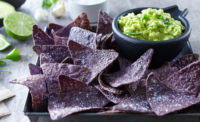Salty snacks experiment with new flavors, vegetables












Per IRI, Chicago, the salty snacks category was valued at $22.6 billion for the 52 weeks ending April 16, 2017—a number that encompasses potato chips, tortilla chips, extruded/puffed snacks including cheese puffs, ready-to-eat (RTE) popcorn, corn chips, pretzels and pork rinds—and sales were up 3.60 percent for the year (see the July “State of the Industry—Snacks” issue for detailed category data).
Many analysts also include other emerging segments in the salty snacks category, such as apple chips, which grew to a value of $21.8 million over the past year.
The salty snacks market is quite active, with many unique flavors and product substrates providing a wider range of diversity and selection than ever before.
Category trends
The salty snacks category is growing. “As consumers’ tastes and palettes are broadening, the demand to sample across snack variants is high,” says Jordan Rost, vice president, consumer insights, Nielsen, New York.
“Food and beverage companies are responding to consumer demand for products that are healthier, natural, and taste great,” says Shari Joslin, vice president, commercial development, FlavorHealth, North Brunswick, NJ.
Genelle Chetcuti, senior director of marketing, RW Garcia, San Jose, CA, says snacks are trending toward more high-protein and high-fiber profiles, with non-GMO ingredients and a clean ingredient deck.
Some consumers want to continue eating the products they love, but with less sodium. FlavorHealth Salty lets manufacturers reduce sodium up to 50 percent while maintaining the same salty taste consumers prefer. “Our solution to salt reduction achieves these significant results while adding only ‘natural flavor’ to the label,” says Ryan Loy, Ph.D., assistant principal scientist, FlavorHealth.
“One of the main trends we are seeing is premiumization,” says Mark Lozano, sales manager, tna, Dallas. “Indulgence remains a key motivator when it comes to snacking, and more and more consumers are opting for high-quality snacks with premium ingredients or decadent flavor combinations.” He points to ingredients like truffle flavors and cider vinegar that can differentiate products.
“Customers are looking for flavors that they enjoyed eating when they weren’t as concerned about calories,” says Andrew Epstein, co-founder, The Little Kernel, Manalapan, NJ. “Customers are seeking savory and hot varieties, as well as the old ‘standbys,’ such as nacho cheese, dill, etc.”
In May, The Little Kernel launched S’mores Popcorn, made with real mini marshmallows. It’s popped with 100 percent pure olive oil, and is gluten-free, non-GMO, dairy-free, kosher and whole-grain.
“Consumers are gravitating toward better-for-you ingredients and aspirational flavors,” says Jerry Bello, founder and CEO, Vintage Italia, Windermere, FL. “Non-GMO, whole-grain, low-fat, etc. are still top-of-mind for mainstream consumers.” Vintage Italia’s non-GMO snacks include Veggie Pasta Chips, offered in varieties like Spinach Broccoli Kale and Roasted Tomato & Red Pepper.
“Yakiniku, the Japanese word for grilled meat, is a flavor trend to watch,” says Yusuke Hiraiwa, national industrial sales/R&D manager, Kikkoman, San Francisco. During IFT, Kikkoman offered yakiniku-flavored potato chips made with granulated gluten-free soy sauce and toasted sesame oil.
Americans have also grown to love hot and spicy food, notes Hiraiwa, and ingredients that were once considered cutting-edge and daring, like chipotle chiles and sriracha, are now woven into our diets and recipes. “Balance and dimension are the next big thing in hot and spicy food—call it ‘hot and spicy 3.0.’”
Building blocks
“The use of naturally nutritious ingredients with added health benefits, such as ancient grains or root vegetables that are high in fiber and low in fat, can help manufacturers shake off the unhealthy perception of salty snacks,” says Lozano. He suggests using oils high in unsaturated fats, such as olive oil.
“For a lot of customers, it’s all about creating unique snacking experiences when it comes to salty snacks. In particular, millennials are looking for experiences that indulge all their senses, whether it’s taste, texture, color or the overall appearance of the product,” explains Lozano.
Ingredients like kale, says Lozano, have therefore become increasingly popular, as they not only deliver health benefits, but also indulge consumers’ senses with their interesting shape, unusual color, and crispy texture.
“Products with kale grew by 13 percent from January 2017 versus a year ago,” says Rost. He notes kale was in nearly 70 different categories across the store, including salty snacks.
RW Garcia uses a blend of corn, grains and veggies in many of its products to naturally provide enhanced flavor and color. “Our line of 3-Seed Artisan Crackers offers a unique blend of flax, sesame and chia, and are naturally colored by beets, kale or sweet potato to add the great component in both flavor and texture while also offering added health benefits,” says Chetcuti. “Grains and seeds offer a great source of plant-based protein, so snacking can be both delicious and better-for-you.”
Salty snacks can benefit from sweet or savory accents. “For me personally, the flavor in salty foods can quickly turn overpowering and ruin a product. In order to keep the salt balanced, I like to round out the flavor with something savory, sweet or acidic,” says Brendan Rigby, head of research and development, Golden Cannoli, Chelsea, MA. “Sweet flavors are very easy to pair with salt, and I like to work with caramel, honey and maple. Umami and acidic flavors can be a little trickier, but staples like lemon juice or malted vinegars tend to pair really well at the right usage rates.”
Hiraiwa notes umami-rich liquid or dry soy sauce can work as a flavor enhancer, salt replacer and precursor for reaction flavors, creating rounded, balanced flavors for virtually any application—from Asian and global to classic American snacks.
Technological advances
“The right frying technology is key when it comes to both production efficiencies and the overall quality of the product,” says Lozano.
tna recently launched a potato chip fryer with “opti-flow” technology, which ensure that each chip is fried evenly and to perfection. This prevents debris from settling and ensures that potato slices don’t absorb or carry any excess oil. As a result, each potato chip is evenly fried, reducing the number of rejects for enhanced product quality and increased yield.
“By implementing innovative oil management technology, snack manufacturers not only ensure that each chip is fried to perfection, but they also achieve a much more efficient oil turnover process,” says Lozano.
tna has been able to improve its oil filtration units so that particles are removed down to 1 micron, he adds, which significantly slows down the formation of free fatty acids.
“This not only extends oil life and lowers raw material costs, but also improves the quality of the filtered oil to ensure it doesn’t affect the taste and color of the end product,” Lozano remarks.
Ongoing innovations
“Customers are looking for fresher foods and new flavors, and this has led us toward new flavor combinations,” comments Rigby. “Saltiness does a great job of rounding-out overpowering flavors. With customers leaning toward fresher foods in general, flavors like watermelon or tomato have the upper hand, because consumers might perceive them as healthier than a more traditional salty flavor like salted caramel or a salty cheese.”
Although not a new trend, chocolate has seen success as a component of salty snacks. “The most-innovative use of chocolate that I’ve seen has been combining wasabi and chocolate. I’ve also seen cayenne and chocolate combinations and, when done well, that’s wonderful too,” says Bello. He notes that Pasta Snacks is exploring some exciting ideas in the sweet snacking space, still based on baked pasta dough.
“Consumers are currently loving turmeric for both its known health benefits and its unique flavor,” says Chetcuti. “The inclusion of more diverse spices is definitely an emerging trend that we anticipate seeing more of in the snack category.”
Hiraiwa suggests a fusion-led approach. “Incredible, rich flavors are born from merging cuisines—which we expect will continue in new and exciting ways,” she says, such as blending Asian and Latin American elements.
“The list for innovation is endless,” says Epstein. “It’s as long as our imaginations will allow.”
Looking for a reprint of this article?
From high-res PDFs to custom plaques, order your copy today!













